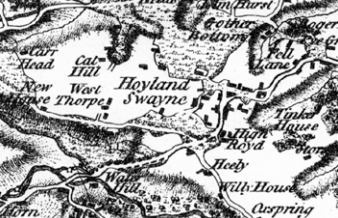If you move to live on the coast it doesn’t take long to discover that your world, enriched as it might be by the presence of the sea, has been reduced. You can no longer travel in all directions, but only, at most, in three. I learned this lesson late. I was brought up in south Yorkshire, almost as far from the sea as you can get in England, and as a boy I was used to walking out from where we lived, to the north, east, south and west, wherever my instinct led me.
Walking was how I got around. My parents never allowed me a bike. It was too dangerous, they would say – though, curiously, they did let me have a scooter. This was in the late 1950s and early 1960s, when motor traffic was much lighter, though it’s true that lorries would thunder down the road from the village to where we lived, opposite the primary school. It was also a time when children could wander at will, all day long, without their parents worrying about where they were or what they were up to, as long as they were back in time for tea. I would wander off, with friends or often alone – we lived at a distance from where most of my friends lived – but rarely with my brother (he was four years younger).
Walking east took me from the house – plain brick, two-up, two-down – across the garden and into a wood. The first bit of the wood my parents owned (it contained a septic tank), but it carried on, across a fence, towards a deeper wooded valley with a stream in the bottom. Downstream led to Guyder Bottom: first a farm, then, beyond, the remains of a small coalpit. Miniature coal mines dotted the woods further on. They were mostly worked out and abandoned, though not that long ago: metal tracks, old wagons and other mining debris were scattered around the blackened earth. Upstream, alongside fields where we sledged in winter snows, led towards The Nook, a street of council houses in the village.
The wood was a favourite place for make-believe play and hiding from adults. Building a den out of fallen tree branches and bracken might take care of a whole morning. It was a safe place, though I have a memory of Billy Trimby, a boy slightly older than me who lived in the post office, disturbing a wasps’ nest one day and roaring through the wood, stung and maddened by the pursuing wasps. For some reason I tended not to venture much east beyond the wood towards Silkstone and the main road.
Northwards from the house, Haigh Lane fell away and then climbed, past Elmhirst farm and on alongside small woods for a mile or two down towards Cawthorne. This was a very common walk, past old houses and cottages built of millstone grit, with plenty of old paths and lanes branching off: Small Lanes that led back to Guyder Bottom, the paths to Tanyard and Hattersley Woods, or another path to Banks Hall. The final wood by the side of the road contained another deserted coal mine. One day a man carrying a theodolite – for some reason I knew what a theodolite was by now – stopped me and beckoned me into the wood. I thought he was going to show me something there. And he was: he started taking his trousers down. I turned and fled, even faster than Billy Trimby, and never told the story to my parents.
Cawthorne was a posher place than Hoylandswaine, a place for middle-class professionals who worked in Barnsley. It has a country house and park, Cannon Hall, and I would often go there, and beyond, climbing up through woods to High Hoyland, at the outer edge of my walking range.
Going west meant passing the school and walking along Cross Lane. The small valley half way along on the right was a good spot for blackberrying with my mother in autumn. In the kitchen she would strain the juices in a muslin bag suspended from an upturned stool on the draining board, bottling jelly rather than jam: she couldn’t stand the stones getting stuck in her teeth. Then on along field paths down to Gunthwaite. There was a dam here among the trees. It was said that a young girl had drowned herself in it, and we kept away from the water. The lane climbed to the site of Gunthwaite Hall and its immense 16th century cruck barn. If I was lucky I’d catch a train going by on the Huddersfield to Penistone line, then climb again to Upper Denby. Or I’d go the other way from Gunthwaite, up to Cat Hill and Crab Tree House and home through the village. Or in the other direction, through Ronksley Wood.
To the south was the village, up a steep hill, past the blackened Victorian church. Our next-door neighbour and school caretaker, Mrs Stephenson, was responsible for cutting the churchyard grass. (We had no television, and I used to spend many hours sitting next door, the curtains drawn, watching the Test Match with Mr Stephenson, who, like many people in the village, worked in the steelworks at Stocksbridge.) Past Enid’s shop, the Methodist chapel, the Rec and the post office, and you reached the main road. To the left was the rest of the village, the Lord Nelson and Skinpit Lane: Hoylandswaine once had several industries, including tanning and nail-making. But I’d turn right, and go over the hill and down to Penistone, a couple of miles further – often to visit the public library, but sometimes to walk further, to the reservoir that was the furthest reach of the ‘Langsett Circular’ bus, and the fieldless edges of the Pennines. This was where the really wild country began.







Leave a Reply to Andrew Green Cancel reply